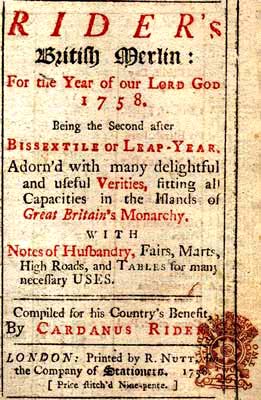

|
Introduction
One of the earliest almanacs to be published, Rider's British Merlin was issued from 1656 until at least 1830. It is generally held that Cardanus Rider is a pseudonym, and near- TNA (The National Archives) in London hold a book by Saunders on palmistry, with horoscopes; also attributed to him is The Astrological Judgment and Practice of Physick, published in 1677, although the fact that it includes charts from as early as 1616 to 1618 has led doubts to be cast on the actual authorship. Be that as it may, its subject matter was dear to the heart of "Cardanus Rider"; it stands as one of the earliest astro- The 1677 book also contains an account of life, death and medicine in the 16th and 17th centuries, with many surprising details. Of the Black Plague of 1593 (with transiting Saturn in the sign of Cancer), the author says, And you shall understand that this Plague was not infectious, because it came of a cold cause; and there was nothing that bred it so soon as the eating of fresh Herrings and Cucumbers and fruit, and such things as breed slimy Flegm and Water; and most commonly where it took a house, it went round amongst children and servants, that were all of one kind of feeding; and those two years was great plenty of fresh Herrings, and much fruit; and there dyed in the year 1593 eighteen hundred a week, and most of the Doctors of Physick did fly from London, and Dr. Foreman staid by it, and thanks God he saved many. (p. 154). Medieval physicians were astrologer, doctor, pharmacist and nurse, all in one. The Astrological Judgment and Practice of Physick describes medieval medical techniques and includes astrological diagnosis and prognosis, as well as symptoms, predictable times of crisis and numerous herbal remedies. These aspects are still reflected in the present almanac, issued eighty years later. The pages devoted to each month of the year are accompanied by advice on what, and what not, to eat and drink, and otherwise how to keep in good health. There are horticultural notes with abundant attention paid to herbs, fruit and vegetables. Phases of the moon, conjunctions of the planets, and details of forthcoming eclipses, also find a place. The lengthiest sections of this little book list annual fairs in England and Wales of fixed and moveable date. The first would generally be associated with a saint's day, while the second would be of the type "second Monday in October". This list of town names and dates represented important information in the days before Agricultural Advisers, Trade Fairs and Job Offices, when the fairs played an important role not only in buying and selling, but also in exhibiting innovations in husbandry, in information exchange and in the hiring of labour. "A Computation of the most remarkable Passages of the Times from the Creation to this present Year 1758" and "A Geographical Description of the World" really take us back two and a half centuries, though some of the dates in the eighteenth century "timeline" should perhaps be taken with a pinch of snuff. The review of, and extract from, The Astrological Judgment and Practice of Physick were taken from the website of the Astrology Center of America. To visit a Glasgow University webpage with more information on Rider's Almanac, and extracts from an annotated copy of 1701, click here. |

 In addition to providing a calendar and useful information, the almanac of the past contained blank pages for personal notes and was used as a pocket book. The almanac reproduced here belonged to Thomas Elkington, an estate servant of William Holbech of Farnborough Hall, Warwickshire. He used it to record his expenses. To see the handwritten content, visit the Farnborough pages of the Littlebeams site -
In addition to providing a calendar and useful information, the almanac of the past contained blank pages for personal notes and was used as a pocket book. The almanac reproduced here belonged to Thomas Elkington, an estate servant of William Holbech of Farnborough Hall, Warwickshire. He used it to record his expenses. To see the handwritten content, visit the Farnborough pages of the Littlebeams site -